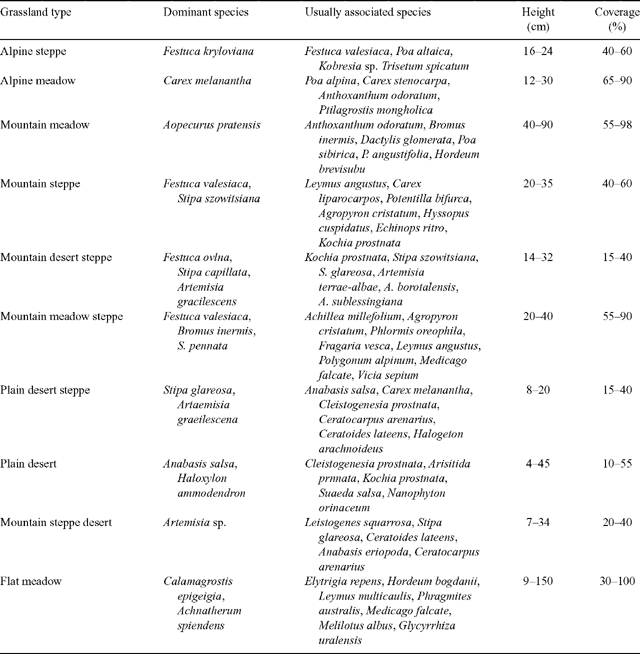A new approach to grassland management for the arid Aletai region in Northern China
Zheng Gang Guo A B , Tian Gang Liang A C , Xing Yuan Liu A and Fu Jun Niu BA Key Laboratory of Grassland Agro-Ecosystem Ministry of Agriculture, College of Pastoral Agriculture Science and Technology, Lanzhou University, Lanzhou City 730020, PR China.
B State Key Laboratory of Frozen Soil Engineering, Cold and Arid Regions Environmental and Engineering Research Institute, CAS, Lanzhou City 730000, PR China.
C Corresponding author. Email: tgliang@lzu.edu.cn
The Rangeland Journal 28(2) 97-104 https://doi.org/10.1071/RJ05018
Submitted: 28 February 2005 Accepted: 30 May 2006 Published: 9 November 2006
Abstract
Land degradation in the arid Aletai Region in northern China is not only detrimental to animal production, but also reduces the ability to conserve water resources by destabilising the catchments of rivers which affects runoff, thus, threatening the sustainable use of these grasslands. A new approach to grassland management based on carrying capacity and ecological services value of grassland types, using an index of classification management (ICG), was designed to ensure the sustainability of grassland ecosystems. In this approach, grassland is classified into 3 management sectors. The first is conservation grassland, which is mainly devoted to ecological and social values; the second is the moderately productive grassland, dedicated to multiple benefits by rational use; and the third is intensively productive grassland, focusing on maximum economic effect. For the arid Aletai region, no intensively productive grassland was available. Conservation grassland occupied 2.5 million ha, accounted for 25.4% of grassland area, and included alpine meadow, mountain meadow, mountain meadow steppe, mountain steppe and flat meadow. In these grasslands, grazing should be eliminated to allow restoration of degenerated areas, protect grasslands with important ecological values from destruction, and to further improve the environment. Moderately productive grassland covered 7.3 million ha, and the grassland types were alpine steppe, mountain desert steppe, plain desert steppe, steppe desert, and plain desert. Agricultural measures, such as fertiliser and irrigation application, should be used to enhance the productivity of these grasslands.
Additional keywords: carrying capacity, classification, ecological services value.
Acknowledgment
This study was supported by National Natural Science Foundation of China (30571316, 30100129 and J0130084).
Ayling R. D., Kelly K.
(1997) Dealing with conflict: natural resources and dispute resolution. Conservation Forestry Review 3, 182–185.

Baron J. S.,
Theobald D. M., Fagre D. B.
(2000) Management of land use conflicts in the United States Rocky Mountains. Mountain Research and Development 20, 24–27.
| Crossref | GoogleScholarGoogle Scholar |

Baumer M.
(1982) Grassland management and the environment. Journal of Rangeland Management 35, 3–4.

Brunson M. W., Steel B. S.
(1996) Sources of variation in attitudes and beliefs about federal grassland management. Journal of Rangeland Management 49, 69–75.

Chen Z. X., Zhang X. S.
(2000) The value of ecosystem services in China. Chinese Science Bulletin 45, 17–22.

Costanza R.,
Arge R.,
de Groot R.,
Farber S.,
Grasso M.,
Hannon B.,
Limburg K.,
Naeem S.,
O’Neill R. V.,
Paruelo J.,
Raskin R. G.,
Sutton P., van den Belt M.
(1997) The value of the world’s ecosystem services and natural capital. Nature 387, 253–260.
| Crossref | GoogleScholarGoogle Scholar |

Guo Z. G.,
Liang T. G., Liu X. Y.
(2003b) Species diversity of grassland communities in the Aletai region of the northern Xinjiang province. Acta Botanica Boreali – Occidentalia Sinica 23, 1719–1724.

Guo Z. G.,
Liang T. G., Liu X. Y.
(2004b) Features of grassland resources and their classified management in Aletai region of Xingjiang. Chinese Journal of Applied Ecology 15, 1594–1598.
| PubMed |

Guo Z. G.,
Liang T. G., Zhang Z. H.
(2003a) Classification management for grassland in Gansu Province, China. New Zealand Journal of Agricultural Research 46, 123–131.

Guo Z. G.,
Wang S. M.,
Liang T. G., Zhang Z. H.
(2004a) Preliminary probe into the classification management for grassland resources. Acta Prataculture Sinica 13, 1–6.

Hong J. S., Hou Y. Z.
(1999) Differentiated forest management – an important way towards sustainable development of tropical forestry. Science Silvae Sinica 35, 104–110.

Jia S. X.
(1980) Discussion on grassland classification in China. China Grassland 1, 1–12.

Li B.
(1997a) Grassland degeneration and its control in northern China. Scientia Agricultural Sinica 6, 1–9.

Li B.
(1997b) Station and problems of grassland resources in China and its countermeasures. Bulletin of Chinese Academy of Science 13, 49–51.

Saunderson M. H.
(1975) Some economic aspect of western grassland management and conservation. Journal of Rangeland Management 28, 75–77.

Smith E. L.,
Sims P., Franzen D.
(1995) New concepts for assessment of grassland condition. Journal of Rangeland Management 48, 271–282.

Tian Y. H., Liu H. Y.
(2003) Advance of several selected topics in landscape ecological studies of grasslands. Chinese Journal of Applied Ecology 14, 427–433.
| PubMed |

Voorthuizen E. G.
(1978) Global desertification and range management: an appraisal. Journal of Rangeland Management 31, 378–380.

Wu S. L.,
Hai Y., Ba T.
(2003) Research on issues of ecological environment in the source regions of two rivers in Aletai Mountain. Environmental Protection of Xinjiang 25, 5–8.

Xie G. D.,
Zhang Y. L., Lu C. X.
(2001) Study on the valuation of grassland ecosystem services of China. Journal of Natural Resources 16, 47–53.


|


